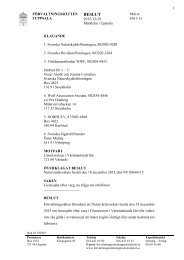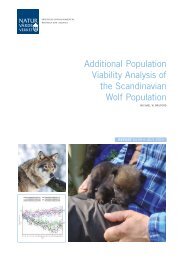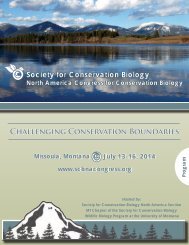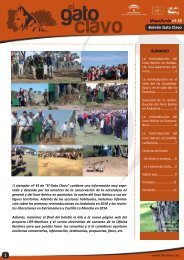1oC3Dbk
1oC3Dbk
1oC3Dbk
Create successful ePaper yourself
Turn your PDF publications into a flip-book with our unique Google optimized e-Paper software.
Terfezia arenaria (a desert truffle). © A. Rodríguez / www.trufamania.com<br />
Congress on Fungal Conservation’ (Turkey, November 2013);<br />
we also support the Arab Society for Fungal Conservation.<br />
We have contributed to the Global Fungal Red List<br />
Initiative, and have evaluated the conservation status of 30<br />
ascomycetes (in addition to the desert truffles already<br />
mentioned); mostly species associated with ash and elm<br />
(trees with rapidly declining populations in Europe and<br />
elsewhere). We held two workshops at the Congress in<br />
Turkey; on raising awareness of fungi, and on preparing<br />
assessments that are compatible with The IUCN Red List<br />
(using desert truffles as an example).<br />
In terms of education and outreach, we are adding<br />
information about fungi to selected pages in the English<br />
language version of Wikipedia, and lobbying to include fungi in<br />
the National Curriculum for schools in England.<br />
We would like to acknowledge the Mohamed Bin Zayed<br />
Species Conservation Fund for its generous support of our<br />
work on desert truffles.<br />
We have a new structure for the current quadrennium with<br />
two co-chairs, John Donaldson and Patrick Griffith; two vice<br />
chairs, Cristina Lopez-Gallego and Michael Calonje; and<br />
DeWet Bosenberg as the Red List Authority.<br />
Planning for the current and future years is underway; we<br />
continue to organize international meetings with the CSG<br />
every three years, the next one scheduled for Colombia in<br />
2015. A conference website was launched last year to<br />
coordinate the conference. We are completing the Red List<br />
Index based on the 2010 assessments and follow up. We are<br />
also planning workshops for 2014 in the USA (Montgomery<br />
Botanical Center) and Thailand (Nong Nooch Tropical Botanic<br />
Garden) to prepare for the next IUCN Red List update in 2015.<br />
All of this activity supports direct conservation<br />
programmes and actions by CSG members. In that area we<br />
are excited to report that three current Save Our Species<br />
(SOS) funded projects are focused on cycads; in South Africa,<br />
Belize, and Colombia. These projects are providing direct help<br />
in the areas of enforcement, monitoring, and ex-situ<br />
propagation techniques.<br />
The CSG gratefully acknowledges SOS – Save Our<br />
Species for this project support, and also Shenzhen Fairy<br />
Lake Botanic Garden, SANBI, and Montgomery Botanical<br />
Center for in-kind support of the activities mentioned above.<br />
Dr John Donaldson and Dr Patrick Griffith<br />
Co-chairs, Cycad Specialist Group<br />
Zamia decumbens – Critically Endangered Cycad known from a limited area<br />
in Belize. © Dr Chad Husby<br />
David Minter<br />
Chair, Cup Fungi, Truffles and Allies Specialist Group<br />
Cycad Specialist Group<br />
The Cycad Specialist Group (CSG) made great progress in<br />
2013, and has further important progress planned for 2014<br />
and 2015. Addressing the world’s most threatened group of<br />
plants, the mission of the CSG is to coordinate worldwide<br />
expertise in cycads in order to conserve these living<br />
treasures. Recent progress meets this mission strategically<br />
and directly.<br />
A major accomplishment of the CSG last year was the<br />
launch of the online ‘World List of Cycads’. At the most recent<br />
CSG meeting (Shenzhen, China, 2011), it was acknowledged<br />
that the accelerating scope and intensity of cycad study often<br />
outpaces print publication. Thus, the CSG decided to<br />
maintain an online World List of valid and accepted species,<br />
updated in real time as the science of taxonomy improves.<br />
This authoritative classification is essential to all other cycad<br />
conservation action.<br />
Other major advancements this year include the<br />
publication of the CITES and Cycads: a user’s guide, (Kew,<br />
2013), and Building living plant collections for conservation: a<br />
guide for public gardens (BGCI, 2014) with Inputs and coauthorship<br />
by CSG members.<br />
50 IUCN species Annual Report 2013






